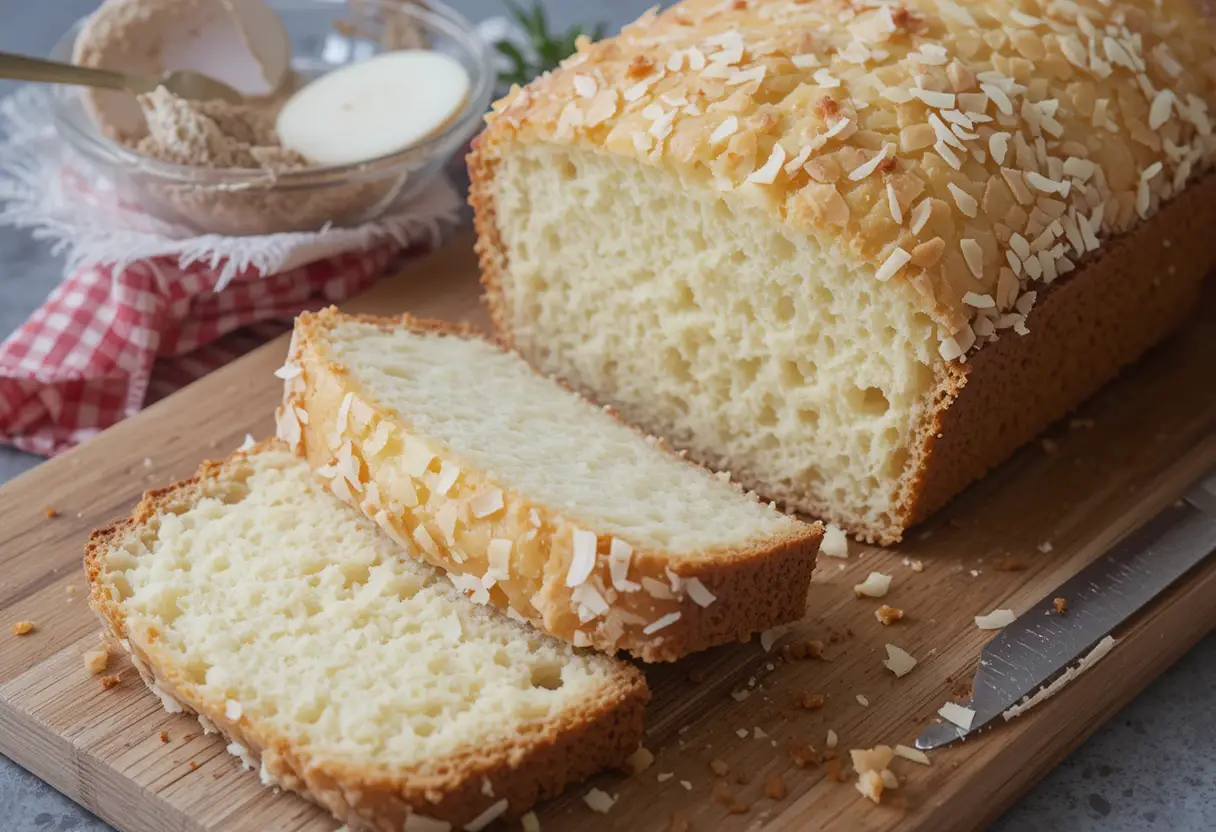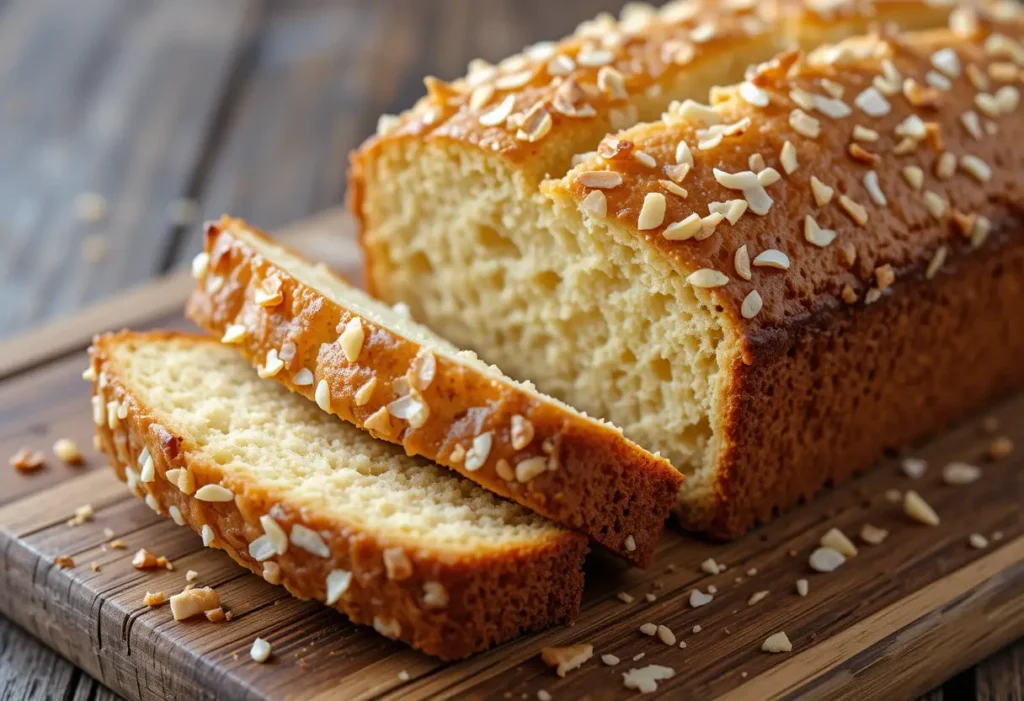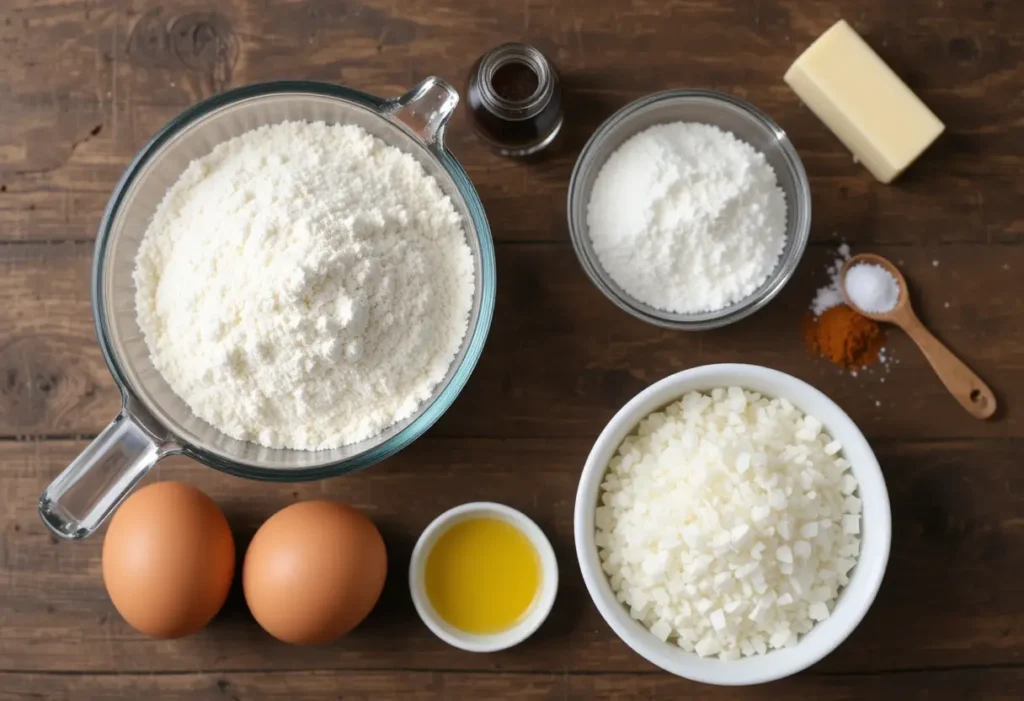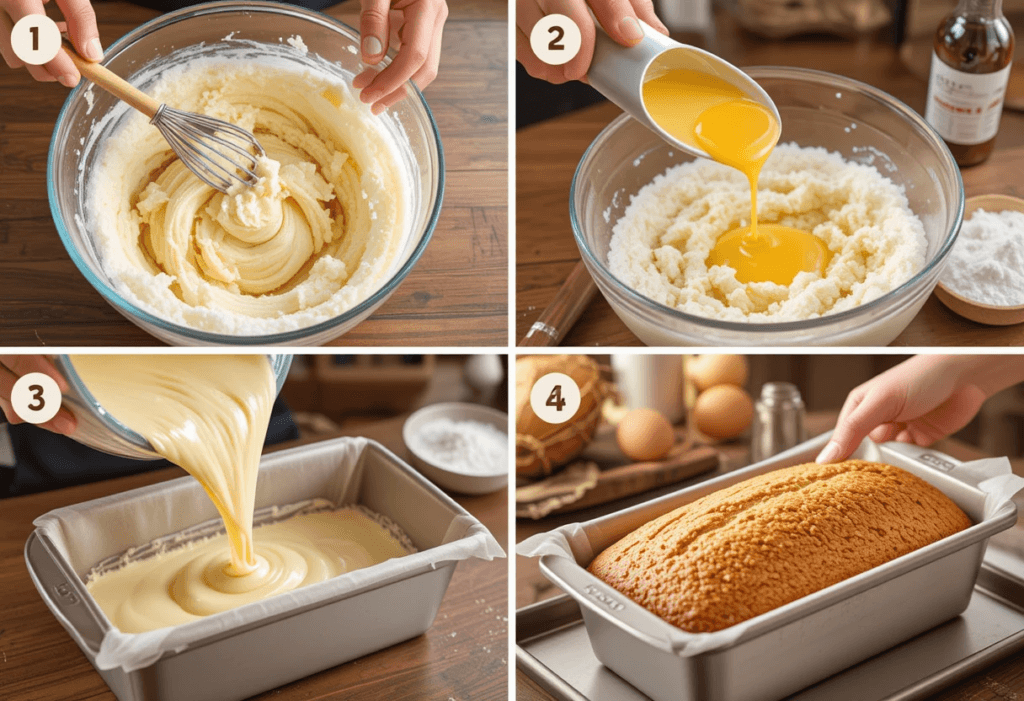Coconut bread is a delightful tropical treat that brings the taste of the islands to your table. Whether enjoyed as a quick breakfast, an afternoon snack, or a special dessert, this versatile bread combines the sweet, nutty flavor of coconut with a moist, tender texture that’s impossible to resist. Perfect for any occasion, this easy-to-make recipe will quickly become a family favorite.
Table of Contents
The Origins of Coconut Bread
Coconut bread has its roots in tropical regions, where coconuts are a staple ingredient and widely cherished in local cuisine. While pinpointing its exact origin is challenging, it remains a beloved delicacy in the Caribbean, Southeast Asia, and the Pacific Islands. Each culture adds its unique twist to the recipe by incorporating local spices, fruits, and ingredients, making every version distinct.
The classic combination of grated coconut, coconut milk, and sometimes coconut oil gives this bread its rich, aromatic taste. Many traditional recipes include nutmeg, cinnamon, or vanilla for extra depth of flavor. Similar to sweet potato cornbread and moist date bread, coconut bread is a comforting homemade treat enjoyed by many.
Why Coconut Bread is a Must-Try
Beyond its delicious taste, coconut bread offers several nutritional benefits. Coconuts are packed with healthy fats, fiber, and essential vitamins, making this bread a satisfying yet nourishing option. Its moist and dense texture pairs well with coffee, tea, or even a scoop of ice cream, similar to how one might enjoy a peach crumble pie.
What makes coconut bread stand out is its versatility. You can enjoy it plain, buttered, or topped with tropical fruit jam for an extra burst of flavor. It also works well when baked as muffins or a loaf, making it perfect for breakfast, snacks, or gatherings. If you enjoy experimenting with tropical flavors, you might also love this pineapple chili salmon recipe for a bold fusion of sweet and savory.
Whether you’re a seasoned baker or a beginner, coconut bread is easy to make and guarantees a rewarding baking experience. The exotic flavor and comforting aroma will transport your taste buds straight to a tropical paradise.
Essential Ingredients for Coconut Bread
The secret to a perfect coconut bread lies in a few key ingredients that enhance its flavor and texture. Just like the carefully selected components in banana brownies or classic vegetable beef soup, understanding each ingredient helps achieve the best results. Whether you’re following a traditional recipe or adapting it for dietary preferences, these ingredients play a crucial role in creating a soft, flavorful loaf.
Key Ingredients and Their Roles
- Flour (2 cups)
- Role: Provides the structural base for the bread. All-purpose flour is most commonly used, but you can opt for whole wheat or gluten-free flour blends if needed.
- Sugar (1 cup)
- Role: Adds sweetness and enhances the natural flavors of the coconut. Brown sugar can be used for a deeper, caramel-like flavor.
- Grated Coconut (1 cup)
- Role: The star ingredient, grated coconut infuses the bread with its signature nutty and tropical flavor. Use fresh, frozen, or unsweetened dried coconut based on availability.
- Coconut Milk (¾ cup)
- Role: Contributes to the bread’s moisture and enhances the coconut flavor. It also adds richness to the texture.
- Eggs (2)
- Role: Acts as a binding agent, providing structure and helping the bread rise.
- Butter or Coconut Oil (½ cup)
- Role: Adds richness, moisture, and a tender crumb. Coconut oil is a great option if you want to intensify the coconut flavor.
- Baking Powder (2 teaspoons)
- Role: A leavening agent that helps the bread rise and ensures a light, fluffy texture.
- Spices (e.g., Nutmeg, Cinnamon – 1 teaspoon each)
- Role: Elevates the flavor profile, adding warmth and depth to the bread.
- Vanilla Extract (1 teaspoon)
- Role: Complements the coconut flavor with a subtle, sweet aroma.
- Salt (¼ teaspoon)
- Role: Balances the sweetness and enhances the overall taste.
Substitutes for Common Allergens in Coconut Bread
- Gluten-Free Alternative for Flour
Replace all-purpose flour with a gluten-free baking blend or almond flour. Add a small amount of xanthan gum (1 teaspoon per cup of flour) to help bind the ingredients. - Dairy-Free Substitute for Butter
Use coconut oil, vegan butter, or a neutral-flavored vegetable oil to achieve a similar texture and richness. - Egg Replacement
Substitute eggs with flaxseed meal (1 tablespoon of flaxseed mixed with 3 tablespoons of water per egg) or unsweetened applesauce (¼ cup per egg). - Low-Sugar Option
Swap granulated sugar for coconut sugar, stevia, or a sugar substitute that suits your dietary preferences.
By understanding these ingredients and their roles, you can adapt the recipe to suit your taste and dietary needs while still enjoying the delicious, tropical flavors of coconut bread.
Step-by-Step Baking Guide
Preparing Your Ingredients
- Measure Accurately: Use measuring cups and spoons for precision, leveling off ingredients to avoid overpacking.
- Room Temperature: Bring eggs, butter, or coconut oil to room temperature to ensure smooth mixing.
- Prepare the Coconut: If using fresh coconut, grate it finely. For dried coconut, soak it in warm water for 10 minutes and drain to restore moisture.
- Preheat the Oven: Set the oven to 350°F (175°C) and grease or line your baking pan with parchment paper.
Mixing Techniques for Perfect Texture
- Dry Ingredients: Sift together flour, baking powder, spices, and salt to remove lumps and ensure even distribution.
- Wet Ingredients: In a separate bowl, cream butter or coconut oil with sugar until light and fluffy. Add eggs one at a time, mixing well after each. Stir in coconut milk and vanilla extract.
- Combine: Gradually mix dry ingredients into the wet mixture. Fold in grated coconut until just combined. Avoid overmixing, as it can make the bread dense.
Baking and Cooling Your Coconut Bread
- Bake: Pour the batter into the prepared pan and smooth the top with a spatula. Bake for 45-50 minutes or until a toothpick inserted in the center comes out clean.
- Cool: Allow the bread to cool in the pan for 10 minutes, then transfer to a wire rack to cool completely.
Variations of Coconut Bread Recipes
Sweet vs. Savory Coconut Bread
- Sweet: Add ingredients like chocolate chips, sweetened coconut, or fruit preserves.
- Savory: Incorporate cheese, chopped herbs, or spices like chili flakes for a unique twist.
Gluten-Free and Vegan Options
- Gluten-Free: Use almond or oat flour and a gluten-free baking mix.
- Vegan: Replace eggs with flaxseed or chia seed gel and butter with coconut oil or vegan margarine.
Incorporating Fruits and Nuts
- Fruits: Mix in diced pineapple, mango, or dried fruits for added sweetness.
- Nuts: Add chopped pecans, walnuts, or almonds for a crunchy texture.
Serving and Presentation Tips
Creative Serving Ideas
- Toast slices and spread with butter or jam.
- Serve with a dollop of whipped cream or a scoop of ice cream for dessert.
- Pair with tropical salsas or coconut-based dips for a unique appetizer.
Best Practices for Presentation
- Garnish with a sprinkle of powdered sugar, toasted coconut flakes, or a drizzle of icing.
- Serve on a wooden platter or with tropical-themed decorations for a festive touch.
Pairing Coconut Bread with Beverages
- Coffee or tea enhances the bread’s sweetness.
- Pair with tropical drinks like pineapple juice or coconut water for a full island inspired experience.
Nutritional Information
Caloric Content and Nutritional Breakdown
- Average Per Slice: ~200-250 calories depending on ingredients.
- Key Nutrients: Healthy fats from coconut, fiber, and moderate protein content.
Health Benefits of Coconut
- Rich in healthy medium-chain triglycerides (MCTs), which provide quick energy.
- Contains dietary fiber for improved digestion.
- Provides essential minerals like magnesium and potassium.
Preserving and Storing Coconut Bread
Short-Term Storage Tips
- Wrap the bread in plastic wrap or aluminum foil to keep it moist. Store at room temperature for up to 3 days.
Freezing and Reheating Instructions
- Freeze: Slice the bread and wrap each piece individually in plastic wrap, then place in an airtight container. Freeze for up to 3 months.
- Reheat: Thaw slices at room temperature or warm in the oven at 300°F (150°C) for 10 minutes.
Common Mistakes and Troubleshooting
Avoiding Common Baking Errors
- Dense Bread: Don’t overmix the batter; it can develop gluten and make the bread heavy.
- Uneven Baking: Use the correct pan size and ensure your oven is preheated to the right temperature.
How to Fix Soggy or Dry Bread
- Soggy Bread: Bake for a few extra minutes or reduce the liquid slightly in the next batch.
- Dry Bread: Increase the coconut milk or add a tablespoon of yogurt or sour cream for added moisture.
This comprehensive guide ensures your coconut bread turns out perfectly every time, whether you’re a beginner or a seasoned baker!
FAQs About Making Coconut Bread
How to Choose the Best Coconut
- Fresh Coconut: If using fresh coconut, look for one that feels heavy for its size, with no cracks. Shake it to ensure you can hear the water sloshing inside, as this indicates freshness.
- Dried Coconut: Choose unsweetened shredded or desiccated coconut for better control over sweetness. Avoid overly dry or stale-looking packages.
- Coconut Milk: Use full-fat coconut milk for a rich flavor and creamy texture. Check labels to ensure no added sugar or preservatives if using canned coconut milk.
- Frozen Coconut: Opt for frozen grated coconut if fresh isn’t available. Thaw it thoroughly before use.
Can Coconut Bread Be Made Without Eggs?
Yes, coconut bread can be made without eggs. Here are some common egg substitutes:
- Flaxseed Meal: Mix 1 tablespoon of flaxseed meal with 3 tablespoons of water per egg. Let it sit for 5 minutes until it forms a gel-like consistency.
- Chia Seeds: Similar to flaxseed, mix 1 tablespoon of chia seeds with 3 tablespoons of water.
- Applesauce: Use ¼ cup of unsweetened applesauce per egg for a mild, sweet flavor.
- Mashed Banana: Replace each egg with ¼ cup of mashed ripe banana for added moisture and a fruity touch.
- Commercial Egg Replacers: Products like Ener-G or Bob’s Red Mill Egg Replacer work well in baking.
These substitutes work well without compromising the texture or flavor of the bread.
Tips for First-Time Bakers of Coconut Bread
- Read the Recipe Thoroughly: Familiarize yourself with the steps and ingredients before starting.
- Prep Ingredients: Measure and prepare all ingredients in advance to avoid missing any steps.
- Don’t Overmix: Stir the batter until just combined to keep the bread light and fluffy.
- Test for Doneness: Insert a toothpick in the center of the bread; it should come out clean or with a few crumbs, not wet batter.
- Cool Completely: Let the bread cool fully before slicing to prevent crumbling.
- Experiment Slowly: If trying variations (like gluten free or vegan), follow the basic recipe first to understand the process.
Following these tips will help you create a moist, flavorful loaf that’s sure to impress!
Conclusion
Coconut bread is a versatile, tropical delight that suits any occasion. Whether you’re baking it sweet, savory, or adapting it to dietary needs, this bread offers endless possibilities for creativity and enjoyment. For more island inspired baked goods, consider trying pumpkin banana loaf for a fall flavor favorite or explore the art of baking brioche to expand your repertoire.
With this recipe and tips, you’re well-equipped to bake coconut bread that’s moist, flavorful, and sure to impress.




